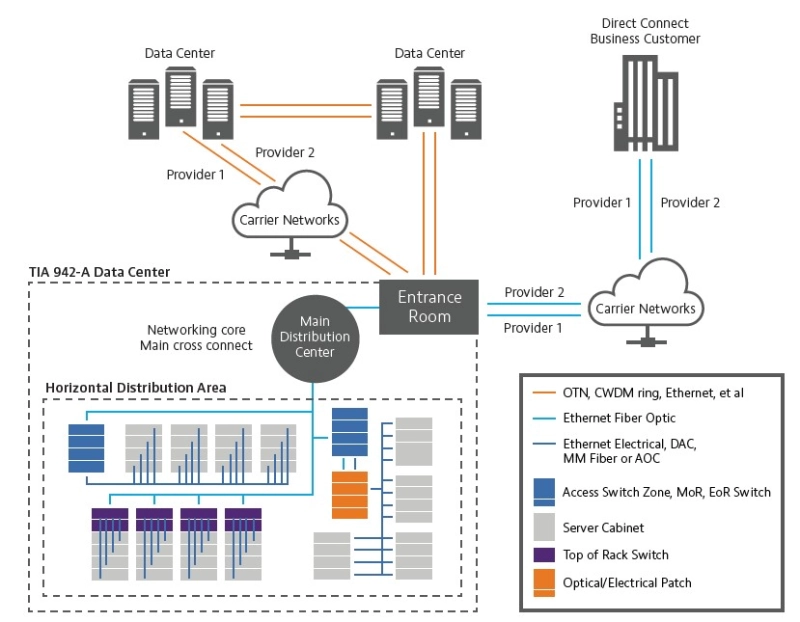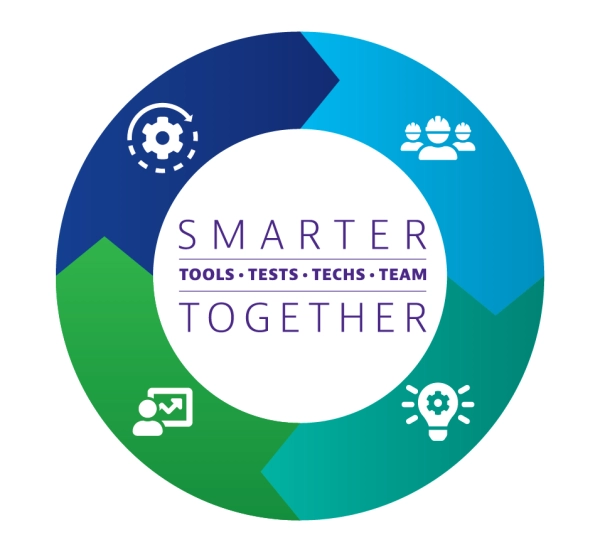What is a Hyperscaler?
Learn all about Hyperscalers, what they do, their relationship with the cloud and the difference between a traditional data center and hyperscaler infrastructure.
A hyperscaler is a large provider of scalable cloud computing, networking, and data storage services. Organizations of all types and sizes now partner with hyperscalers to flexibly grow and customize their networks and applications.
- According to the International Data Corporation (IDC) definition, hyperscalers utilize at least 5,000 servers and 10,000 square feet of floor space, although many data centers are significantly larger.
- Synergy Research Group data shows that Amazon Web Services (AWS), Microsoft, and Google account for over half of all hyperscale installations. IBM and Alibaba are also among the top hyperscalers.
- The total number of companies meeting the hyperscaler criteria remains relatively low, with almost 40% of all hyperscale deployments within the U.S.
- Hyperscalers typically maintain the in-house technical skills needed to customize data center hardware and software according to their business model and applications.
What Does a Hyperscaler Do?
Hyperscalers have reshaped the network landscape by providing highly adaptive computing and storage services. Enterprises leveraging hyperscale capabilities have quickly pivoted to virtualized infrastructure, global commerce, and remote working trends.
- Infrastructure as a Service (IaaS): Providing physical infrastructure to customers via the public cloud is a primary value proposition for hyperscalers companies. IaaS allows enterprises to focus more resources on innovation. It also provides instant scalability and access to a flexible test environment.
- Software as a Service (SaaS): Hyperscalers offer convenient, cloud-based delivery of application software, including configuration services and automated software updates. SaaS benefits customers through reduced installation expenses, rapid deployment, and advanced, cloud-based security features. Many tier 2 hyperscalers have achieved this distinction based on SaaS offerings alone.
- Mainframes: The software and machinery that establish mainframe architecture perform essential functions for the banking, insurance, and healthcare industries. Top hyperscalers now offer mainframe migration services that emphasize the security and reliability of the hyperscale cloud.
- Colocation services: Hyperscalers frequently lease available space, power, and cooling capacity to other organizations. Through strategic partnerships with approved vendors, they have also extended the reach of their technical offerings into less accessible geographic regions.
Long before hyperscale architecture reached its current proportions, IaaS and SaaS were recognized as models of efficiency and convenience. Hyperscalers have shifted their capacity into overdrive, resulting in additional benefits and applications for the hyperscale cloud.
- Hyperscaler partnerships are commitments that extend beyond the traditional customer-supplier relationship. A good partnership includes a clear-sighted assessment of cloud objectives, growth projections, and geographic scope.
- The telecom industry has traditionally favored a private cloud strategy to ensure five nines (99.999%) availability. Evolving cloud-native 5G services are changing the equation by creating a more dynamic and disaggregated core with computing and storage demands that align with hyperscale solutions.
- The IoT relies on ultra-low latency and high connectivity to support 5G applications such as Advanced Driver-Assistance Systems (ADAS), Factory Automation, and Connected Health. As this inevitable transition expands the scope of cloud architecture, top hyperscalers plan for the long-term expansion of the intelligent edge.
Evolution of Cloud Hyperscalers
Hyperscaler evolution can be traced to the first transfer of data and applications from local server rooms to the cloud. This transition has become a watershed event for top hyperscalers as well as their partners and clients. As the data centers have grown larger over time, hyperscalers cloud offerings have adapted to the latest technologies.
Automation and artificial intelligence enable high-volume traffic management and network self-healing processes. Hyperscalers continue to develop orchestration software to improve their efficiency and reliability through intelligent workflows. Automation is also essential for test solutions performing fiber inspection and certification, high-speed throughput verification, BER testing of data center interconnects (DCIs), and end-to-end verification of 5G network slices.

- Hyperscaler Monitoring has evolved from passive performance measurement against pre-defined standards into an active process that provides in-depth insight into network health. Observability solutions are used by hyperscalers companies to automate root cause analysis, streamline capacity planning, and predict problems before they occur. At the same time, remote fiber monitoring practices quickly detect degradations or intrusions to reduce OpEx and MTTR.
- 5G adoption introduces new opportunities for hyperscalers that alter the course of their evolution. Implementation of virtualized core architecture by communications service providers (CSPs) is an important step towards relocating these functions to the cloud. An elevated hyperscaler presence at the edge and virtualized Open RAN (O-RAN) architecture will further this progression.
Hyperscaler infrastructure is often mischaracterized as a super-sized version of the traditional data center model. In reality, expanding the size of a conventional data center only reduces its speed and reliability. The addition of software-defined infrastructure, automation, and machine learning to fully harness the hardware capacity turns potential drawbacks and inefficiencies into benefits.
- Siloed architecture within a conventional data center creates visibility challenges and limits the portability of data and applications. Hyperscalers take a more integrated approach, combining a discrete software layer with commodity servers to effectively remove intelligence from the hardware.
- Deployment of software and services in the traditional data center model is a manual process that often takes weeks to complete. Automated deployment and change management features built into hyperscaler infrastructure can reduce deployment times to minutes.
- Application Programming Interfaces (APIs) are protocols and specifications that allow virtualized infrastructure to be manipulated and dissimilar hyperscale systems to exchange information. Traditional data centers rely on less efficient manual processes to complete these resource configurations and exchanges.
As hyperscalers contend with rising demand, compressed construction timelines, and the disaggregation brought on by 5G and the IoT, robust testing during data center construction, activation, and maintenance gains importance. VIAVI has developed advanced test and monitoring solutions that enable hyperscalers to consistently meet high quality and reliability standards.
- Automated Testing: Improved test process automation (TPAv) minimizes installation schedule impact while reducing unplanned service issues post-deployment. The software-based Fusion test agent can be used to virtually monitor networks, verify SLAs, and automate Ethernet activation tasks such as RFC 6349 TCP throughput testing.
- Automated VIAVI fiber testing tools include the handheld Optimeter optical fiber meter and the SmartClass Fiber MPOLx optical loss test set. These advanced solutions deliver accurate and comprehensive fiber test results in seconds, making the “no-test” option irrelevant.
- Observability: The goal of observability in network computing is to answer any question about a network quickly and easily. The VIAVI Observer platform utilizes valuable network data sources to produce intuitive dashboards and actionable insights. This results in faster problem resolution, improved scalability, and optimized service delivery. Learn more about Performance management and security.
- 5G Networks: Distributed, disaggregated 5G networks bring more demand for hyperscaler solutions and virtual testing of network functionality, applications, and security. The TeraVM solution is a valuable tool for validating both physical and virtual network functions and emulating millions of unique application flows to assess overall QoE. Learn more about our complete end-to-end RANtoCore™ testing and validation solutions.
Hyperscalers continue their expansion as the global demand for cloud computing and big data storage reaches new levels. Top hyperscalers are deploying closer to the edge to accommodate breakthrough 5G use cases. VIAVI provides the multi-dimensional visibility, intelligence, and insight needed to efficiently manage physical and virtual hyperscale environments and profitably deliver innovative services.
VIAVI offers a fully-integrated portfolio of cloud-enabled, automated instruments, systems, and services for network testing, performance optimization, and service assurance. These flexible and interoperable solutions allow hyperscalers and their clients to leverage prior monitoring investments and streamline workflows for greater operational and capital efficiency.
To help keep pace with ever-changing industry trends, VIAVI works side-by-side with standards bodies and equipment manufacturers to ensure our solutions support next-generation technologies. Advanced test products spanning the hyperscaler ecosystem include automated fiber certification and monitoring tools, virtual network management solutions, and industry-leading emulation tools to assess QoE throughout the network lifecycle.

